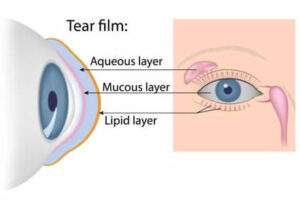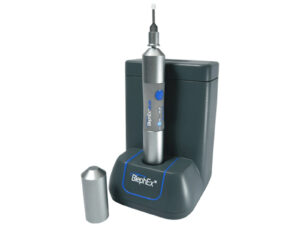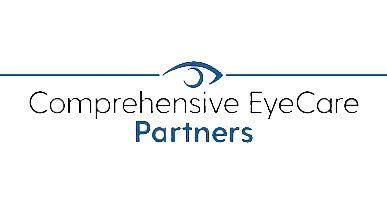Are your eyes tired and irritated? Do you have blurred or double vision?
These could be symptoms of dry eyes or dry eye syndrome. Dry eyes happen when you lack enough tears or don’t make the correct kinds of tears.
Dry eye syndrome is a highly prevalent eye condition that causes uncomfortable symptoms that often come and go. But if your symptoms linger for months, you might be experiencing chronic dry eyes.
Keep reading to learn more about dry eyes, signs that it could be more than irritation, and the available treatment options.
What is Dry Eye Syndrome?

Dry eye syndrome occurs when your eyes cannot create an adequate amount of tears or the tears are of poor quality. In both cases, there’s usually an imbalance in your tear film.
Your tear film comprises three layers: an oily, watery, and mucus layer.
The Oily Layer
The meibomian glands make up the outermost oily layer. It keeps the tear film smooth and prevents tears from evaporating too fast.
The Watery Layer
The watery layer is the middle layer of your tear film. It’s made in the lacrimal glands and helps hydrate and lubricate your eyes.
The Mucus Layer
The conjunctiva secretes the inner mucus layer. It ensures the tear film remains attached to your eyes.
The mucus layer also spreads the watery layer over the surface of your eyes, keeping them moist.
Together, all three layers keep the surface of your eyes comfortable and healthy. You can develop dry eye syndrome if there’s an issue with any of the three layers.
Types of Dry Eyes
There are two main types of dry eyes. They include:
Evaporative Dry Eyes
Evaporative dry eye is the most common form of dry eye syndrome. It happens when meibomian glands don’t produce enough oil, causing your tears to evaporate too quickly.
Evaporative dry eye is typically caused by an eye condition called meibomian gland dysfunction (MGD). Meibomian gland dysfunction occurs when the meibomian glands become blocked, reducing the amount of oil produced.
Their blockage leads to the rapid evaporation of tears and makes your eyes dry.
Aqueous Deficient Dry Eyes
You can get aqueous deficient dry eyes when your eyes can’t stay sufficiently lubricated, making them too dry.
Signs of Dry Eye Syndrome
The signs and symptoms of dry eye syndrome usually affect both eyes. They include:

- Redness
- Eye fatigue
- Watery eyes
- Sensitivity to light
- Blurred or double vision
- A gritty or scratchy feeling
- Difficulty wearing contact lenses
- Stringy mucus around or in your eyes
Signs of Chronic Dry Eyes
When your dry eyes are beyond irritation, the symptoms don’t go away. Instead, they get worse and may last for a long time.
Some of the signs of chronic dry eyes include:
Excessive Dryness
You may have chronic dry eyes if no tears fall, even when you want to cry. Tears are crucial for healthy, comfortable eyes.
Not producing enough tears is a cause for concern. It’s essential to see your ophthalmologist to find an effective solution.
Too Much Discomfort with Contacts

Chronic dry eyes and contact lenses are never a good combination. For starters, contact lenses reduce the amount of oxygen reaching your eyes, exacerbating dry eye symptoms.
Your eyes must also have sufficient tears for contact lenses to provide clear vision and maintain their shape. Since that’s not the case with dry eyes, your contacts can become too dry and lose shape, causing irritation, discomfort, and vision problems.
Lastly, contacts can stick to the surface of your eyes when they’re too dry. Having contact lenses that adhere to the surface of your eyes makes it difficult to remove them, which can make feelings of discomfort even worse.
Once you get treatment for your dry eyes, you can start wearing contact lenses comfortably.
Artificial Tears Don’t Provide Relief
For some people, over-the-counter artificial tears successfully manage their dry eye symptoms. But in others, these eye drops might stop working or not work at all.
If you constantly use artificial tears that don’t help or provide relief, you may have chronic dry eyes. Over-the-counter drops do not work as well for severely dry eyes.
Experiencing persistent dry eye symptoms is a sign that you should see your ophthalmologist to determine the root cause of your problems.
Treatment Options for Dry Eyes
Some of the treatment options available at Evergreen Eye Center include:
BlephEx

Blepharitis is the inflammation of the eyelids, which may lead to meibomian gland dysfunction and, consequently, dry eyes. But when blepharitis is left untreated, it can cause chronic dry eyes.
BlephEx is a painless, in-office treatment for blepharitis. The treatment is administered using a small handheld device.
This device comes with a medical-grade sponge that spins to gently and precisely exfoliate, clean, and remove bacteria and debris on your lids and lashes. Removing the bacteria, debris, and scurf responsible for eyelid inflammation and dry eyes clears blocked oils.
This allows your tears to attain the balance they need to keep them from evaporating too fast. BlephEx treatment lasts approximately 6 to 8 minutes.
Your eye doctor may suggest multiple treatment sessions to address chronic dry eyes. Still, most patients begin to experience relief almost immediately after treatment.
iLux
iLux is a handheld device that applies gentle pressure and heat to your eyelids. The heat and pressure open up blocked meibomian glands, enabling them to release their oil naturally.
The oil restores your tear film’s natural balance, alleviating dry eye symptoms. iLux treatment takes about 8 to 12 minutes for both eyes.
Patients experience noticeable relief after approximately a month of treatment. But depending on the severity of your symptoms, you may require repeat treatments every few months to achieve long-term relief.
Don’t Live with Dry Eyes

Chronic dry eyes don’t improve on their own. That’s why it’s essential to seek treatment at Evergreen Eye Center. Our experienced team can provide a long-term solution to alleviate your symptoms and restore your eye health.
Are you ready to get to the bottom of your dry eyes? Schedule your appointment today at Evergreen Eye Center to start your journey to lasting relief.

